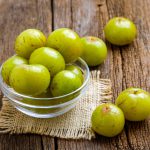Ashwagandha in Sanskrit means “smell of the horse” to correlate it with the strength of…
Read MoreWho doesn’t enjoy a soothing massage? According to Ayurveda, a massage with oil or ghee – or abhyanga, as it’s called in this ancient science – is a must for those who desire happiness and health. In fact, it is considered to be an important part of the daily routine or dinacharya of a healthy person. Now that’s some ancient advice we can certainly get on board with!
Ayurveda considers daily abhyanga important for all healthy people. If it’s not possible to have a whole-body massage then you are supposed to apply oil to at least important body parts like your head, foot, and ears daily in order to have a healthy life.[1]Roshy Joseph, C., C. Anu, and C. T. Joseph. “Role of Abhyanga (oil massage) to lead a healthy life.” Ayurpharm international journal of ayurveda and allied science 1, no. 7 (2012): … Continue reading
Abhyanga is also advised during the period when the seasons change. It is said to have a protective effect when the weather is cold and dry too.
Ayurveda suggests that three forces or doshas known as vatta, pitta, and kapha control your physiological and psychological processes. These doshas are associated with the elemental aspects of water, fire, space, earth, and air. Based on your physical and mental attributes you can discern which dosha is predominant in your constitution (prakruthi). The medium used for abhyanga is usually related to your body constitution.
Sesame oil is considered good for all constitutions or prakruthis since it can balance all three doshas (tridoshagna). It is thought to be nourishing for the body. It contains linoleic acid which has potent anti-inflammatory effects and also inhibits harmful bacteria.
If your ayurvedic doctor recommends abhyanga for treating a specific condition, they might suggest that you use a medicated oil. Various medicated oils such as Triphaladi taila, Chandanadi taila, Bhringamalakadi taila, Ksheerabala taila etc. are used in Ayurveda for treatment.[3]Roshy Joseph, C., C. Anu, and C. T. Joseph. “Role of Abhyanga (oil massage) to lead a healthy life.” Ayurpharm international journal of ayurveda and allied science 1, no. 7 (2012): … Continue reading
Ayurvedic texts describe a range of benefits offered by abhyanga. It is thought to:
It is important to note that research suggests that massages can be helpful in managing conditions like anxiety, stress, insomnia, high blood pressure, and low back pain. Most of us experience a feeling of calmness and relaxation when we get a massage. This is due to the release of endorphins, which are neurotransmitters which give you a feeling of well being. A massage can also lower stress hormones like cortisol, adrenalin, and norepinephrine. It has also been found to offer a range of physical benefits such as reducing muscle tension, improving circulation, stimulating the lymphatic system, and improving joint flexibility as well as skin tone.[6][Massage](https://www.betterhealth.vic.gov.au/health/conditionsandtreatments/massage “Massage”). Better Health Channel.
Ayurvedic practitioners suggest that people suffering from certain disorders should not practice abhyanga:
You should also check with your doctor before getting a massage if you:
References
| ↑1, ↑3, ↑4, ↑9 | Roshy Joseph, C., C. Anu, and C. T. Joseph. “Role of Abhyanga (oil massage) to lead a healthy life.” Ayurpharm international journal of ayurveda and allied science 1, no. 7 (2012): 163-167. |
|---|---|
| ↑2 | Sharma, Shikha, Seema Puri, Taru Agarwal, and Vinita Sharma. “Diets based on Ayurvedic constitution–potential for weight management.” Alternative Therapies in Health & Medicine 15, no. 1 (2009): 44. |
| ↑5 | [Advantages Of Abhyanga (External Snehana)](http://www.ccras.nic.in/node/1025 “Advantages Of Abhyanga (External Snehana)”). Central Council for Research in Ayurvedic Sciences. |
| ↑6, ↑10 | [Massage](https://www.betterhealth.vic.gov.au/health/conditionsandtreatments/massage “Massage”). Better Health Channel. |
| ↑7 | Pachghare, Madhuri Anil, and Vd Priya Vishal Naik. “Role of Abhyanga in Skin and Hair Care.” Journal of Ayurveda and Integrated Medical Sciences 5, no. 04 (2020): 169-176. |
| ↑8 | Kutiyal, Priya, Sanjay Gupta, Parul Sharma, and Lalita Sharma. “Role of jyotishamati taila abhyanga in the management of the shvitra WSR vitiligo: A clinical study.” Environment Conservation Journal 20, no. SE (2019): 53-56. |


Dr. Manjula has 12 years of experience in the field of Ayurveda and worked as a Consultant and General Physician for over 5 years before starting her private practice. In addition to BAMS, she also has an Advanced Diploma in Clinical Research and is trained in Panchkarma. She is an expert at diagnosis of the root cause and planning effective treatment for multiple issues.

Ashwagandha in Sanskrit means “smell of the horse” to correlate it with the strength of…
Read More
Pimples - we’ve all had them and we all hate them. And if you’ve ever…
Read More
Don’t all of us want healthy glowing skin? And while there is a ton of…
Read More
Most of us have experienced skin irritations at some point or the other. When the…
Read More